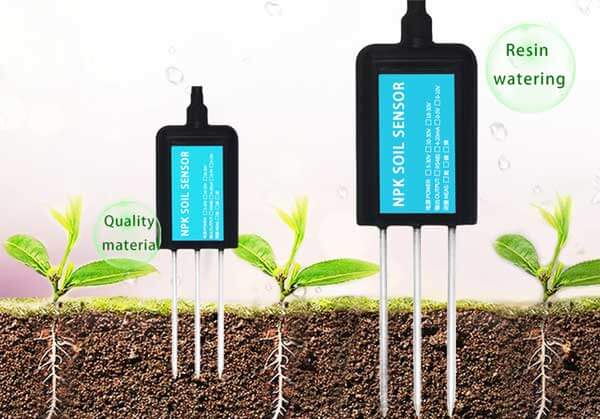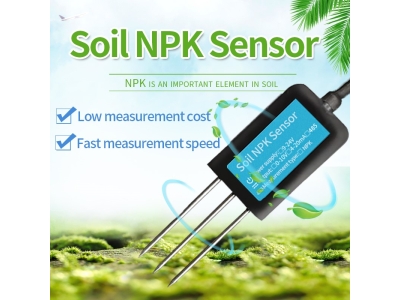Agriculture is transforming rapidly with the advent of new technologies. One such groundbreaking innovation is the use of soil sensors in precision agriculture. These sensors have the potential to revolutionize farming practices by providing real-time data on soil conditions, enabling farmers to make informed decisions and optimize crop production. This article explores the significance of soil sensors in precision agriculture, their applications, advancements, and future prospects.

Understanding Soil Sensors:
Soil sensors are devices that measure various parameters of the soil, including moisture content, temperature, pH levels, nutrient levels, and salinity. They utilize different technologies such as capacitive, resistive, and electromagnetic methods to accurately capture soil data. Soil sensors can be installed at different depths in the soil profile, allowing for comprehensive monitoring of soil conditions.
Importance of Precision Agriculture:
Precision agriculture aims to optimize crop production while reducing inputs and environmental impact. By adopting precise and targeted farming practices, farmers can minimize resource wastage, increase productivity, and mitigate environmental risks. Soil sensors play a critical role in precision agriculture by providing valuable information about soil conditions that influence plant growth and development.
Applications of Soil Sensors in Precision Agriculture:
Soil sensors have diverse applications in precision agriculture:
3.1 Irrigation Management:
Proper irrigation is crucial for optimal crop growth. Soil sensors help farmers determine when and how much water to apply by measuring soil moisture levels. Real-time data from soil sensors allow farmers to precisely schedule irrigation, avoiding overwatering or underwatering. This not only conserves water resources but also prevents waterlogging or drought stress, improving crop health and yield.
3.2 Nutrient Management:
Soil nutrient levels directly impact plant nutrient uptake and growth. Soil sensors measure nutrient concentrations, such as nitrogen, phosphorus, and potassium, in the soil. This enables farmers to tailor fertilizer applications based on actual nutrient requirements, avoiding overuse or wastage. By implementing targeted nutrient management, farmers can optimize nutrient utilization, reduce costs, and minimize environmental pollution.
3.3 Soil Health Monitoring:
Soil health is crucial for sustainable agriculture. Soil sensors provide insights into soil pH levels, organic matter content, and microbial activity. This information helps farmers monitor soil quality and identify potential issues such as soil acidification or nutrient depletion. With timely interventions based on soil sensor data, farmers can maintain soil fertility, enhance soil structure, and promote beneficial soil organisms.
3.4 Crop Disease and Pest Management:
Soil sensors can assist in early detection and management of crop diseases and pests. Certain soil conditions favor the development of pathogens or pests. By monitoring soil parameters such as moisture, temperature, and pH, farmers can anticipate disease or pest outbreaks. Timely preventive measures, such as adjusting irrigation or implementing targeted pest control strategies, can be taken based on soil sensor data, minimizing crop damage and reducing the need for chemical interventions.
Advancements in Soil Sensor Technology:
Advancements in soil sensor technology have expanded their capabilities and usability:
4.1 Wireless Connectivity and Remote Monitoring:
Modern soil sensors can be integrated into wireless networks, enabling remote monitoring and data transmission. Farmers can access real-time soil data from their smartphones or computers, allowing them to stay informed about soil conditions without physically visiting each field. This improves operational efficiency and facilitates timely decision-making.
4.2 Data Analytics and Machine Learning:
Soil sensor data, combined with data analytics and machine learning algorithms, offer valuable insights into crop performance and soil behavior. By analyzing historical data, patterns, and correlations, farmers can gain a deeper understanding of factors influencing crop growth. Machine learning models can provide recommendations for optimal irrigation and fertilization strategies, improving resource management and crop productivity.

4.3 Sensor Fusion and Integration:
The integration of multiple sensors, such as soil moisture, temperature, and nutrient sensors, provides a holistic view of soil conditions. Sensor fusion techniques combine data from different sensors to generate more accurate and comprehensive information about the soil environment. This integration enhances the precision and reliability of soil sensor measurements, enabling farmers to make more informed decisions.
